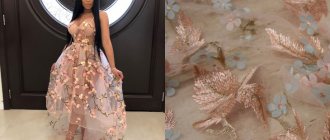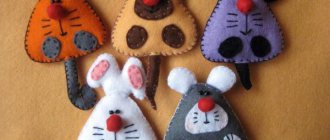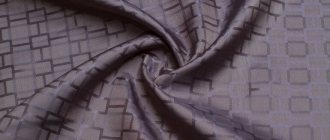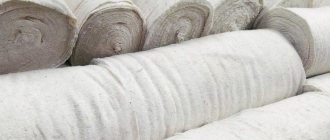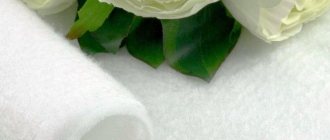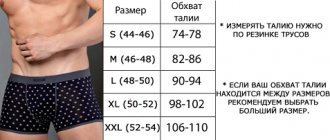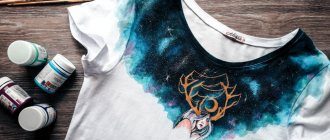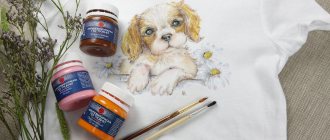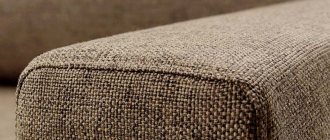Nowadays the world is captured by the fashion for everything natural, environmentally friendly and as comfortable as possible. It is these three concepts that are most characteristic of a fabric such as linen. Linen fabric has a very rich history; it appeared more than 5 thousand years ago. No one knows who exactly was the first to use flax to make fabric. It is known that in Switzerland fishing nets and ropes for hunting were woven from fiber. In ancient times, linen was the fabric of the rich; Egyptian and oriental craftsmen achieved special skill in its production.
Now linen is one of the most versatile and popular natural products. It is used to make many products used in various spheres of human life. In this article we will dwell in more detail on the technique of creating matter, its features, types, pros and cons.
Linen - description of the fabric
A material with its own characteristics. Flax is quite difficult to grow and process. We will talk further about how it is done and what it is.
Flax production
It grows only in temperate climates with good humidity. In order for it to grow well, the temperature should be moderate and the daylight hours should be long.
In the CIS countries, flax is practically not grown, since for many farms this crop is unprofitable.
There are many types and subspecies of flax, but only spinning flax (also known as long flax) is used for production. This culture has been used in the woven industry for a long time; the technology for making the material is also very ancient.
It is more difficult to grow and produce flax than cotton, which is why it costs more.
It is noteworthy that even now they are made using the same technique. Except that production has become a little automated.
Made this way:
- Collecting plants with a combine and grinding them into straw.
- Spreading straw on the field for 2-3 weeks. During this time, the flax is saturated with dew and separates its fibrous part, which is called trusta.
- Straw collection, drying and mechanical processing.
- Combing out the trust and forming a strip.
- Forming a thin, slightly twisted thread from a tape, called roving.
- Weaving.
- At the last stage it undergoes aesthetic treatment. It is bleached or dyed in different colors.
Texture and density: what it looks and feels like
With a smooth surface and matte shine. The material is quite dense, but not rough. Its texture is reminiscent of very structured cotton.
It feels very pleasant to the touch. Despite its density, it conducts air and heat well. Popular among allergy sufferers because it does not irritate the skin.
Properties and quality of the material
Refers to those plant tissues that do not stretch at all. If you plan to sew clothes, be sure to take this nuance into account. You also need to take into account that, due to its natural origin, it shrinks quite a lot when washed. This is especially true for washing in hot water.
If you sit in a linen blouse/dress/pants, there will definitely be creases on the product.
It wrinkles a lot. Perhaps this is the most wrinkled natural material.
Advantages and disadvantages
At different times, linen enjoyed enormous popularity. And this is not surprising, because it has a wide range of advantages:
- Environmentally friendly. This is a completely natural material. Its production does not require any chemicals or other substances that in any way harm the environment.
- Wear resistance. Remains attractive for many years. It holds up well to daily use and numerous washes. Another advantage of flax is that it does not wear out and does not turn yellow.
- Comfortable to wear. Refers to breathable fabrics that are permeated with many micropores. Air can circulate freely through these pores. Linen products are not hot in summer and not cold in winter. The material is also highly hygroscopic. It absorbs sweat well.
- Hypoallergenic. Material for allergy sufferers and asthmatics. It does not contain aggressive components that can cause allergic reactions. Microsatin also has these properties.
- Mold resistance. Even dense fabrics can inhibit most bacteria and fungi. Such products do not stick to the body and provide moisture and air exchange.
Linen is also a natural antistatic agent. Due to the fact that linen products are not electrified, they become less dirty and do not attract dust.
There are several features:
- Strong creasing. As already mentioned, linen products wrinkle very much, and it is quite difficult to smooth out the resulting creases. However, it is worth remembering that strong creasing is an indicator of the natural origin of the material. If having a few folds on your clothes is critical for you, then linen is definitely not for you.
- High rigidity. Linen is not as soft and pliable as cotton, it holds its shape well. You can sew items with interesting shapes, such as a blanket for a corner sofa.
- Shattering. During sewing, the material can fray and crumble quite a lot. Because of this, when working with linen, you need to pay special attention to the processing of seams.
This is a unique natural material. Its advantages far outweigh the disadvantages. This is a truly beautiful, versatile and high-quality fabric that is suitable for creating a wide variety of products.
A little history of the origin of the fabric
Flax is rightfully considered a universal crop: it is used to produce textile materials, medicinal raw materials, food additives (seeds) and products (oil), ropes and technical products.
The plant has been known since ancient times. Artifacts indicate that flax fibers were used 5 thousand years ago. The mummies of Egyptian pharaohs were wrapped in bandages made from such threads. Three thousand years ago, the Etruscans made books whose pages were made from flax. On ancient frescoes, historians have found evidence of the cultivation, collection and processing of this crop.
Residents of modern territories of Switzerland and Germany cultivated flax in the Stone and Bronze Ages. Here the fiber was used mainly for making fishing gear and ropes. Interestingly, in Ancient Egypt there was a special technology for producing fabric from linen yarn. The textile was so thin that it easily passed through the ring and was translucent.
It is also known that in Rus' flax was cultivated by Slavic tribes long before the formation of the state of Kievan Rus. In those days, cultivation and weaving were used for one's own needs. It was only in the 13th century that fabrics began to be produced for commodity exchange. In the 19th century, thanks to the French mechanic Philippe Girard, who developed the technology for producing thin flax fiber mechanically, a manufactory was created in Russia that supplied textiles for export. By the end of the 19th century, a third of the proceeds from the supply of goods to other countries went to the treasury through the sale of such paintings.
In the USSR, the material belonged to the group of ordinary ones, while in Europe it was considered a premium fabric. The revival of flax production in modern Russia has become one of the tasks supported at the legislative level.
Types: what is considered to be linen fabrics
There are many types and subtypes of matter on the market. The type, density and area of use depend on the type of thread weave during the production process. The type of weave is:
- Linen is a classic linen fabric.
- Jacquard (large patterned weaving) - textured, dense and durable material.
- Twill - with high tear resistance, which is characterized by the presence of diagonal lines on the material.
- Patterned (matting) - with rough weaving, but pleasant to the touch.
Also available with openwork weaving.
Some manufacturers add other materials to flax, which causes it to slightly change its properties. Let's look at the main types of flax, their properties, advantages and disadvantages. Find out how to make a canvas for a projector here.
How is linen made?
For the manufacture of linen, two modifications are most often used:
- Batiste is a thin fabric with a plain weave.
- Damascus is a fabric with a fibrous weave.
Linen is soft and thin, but very durable. Products made from such flax are quite inexpensive, but they last a long time.
Dense and coarse fiber
Dense is a material with a large number of flax fibers. It is really very dense and holds its shape well. These types are very wear-resistant; they wear out little during operation.
Technical
Technical, which is also often called terraced, has a high density and coarse structure. Such matter is almost impossible to tear apart manually. Technical flax is used to make ropes, bags, canvases and much more.
Seamless texture
Seamless is a material with the most smooth and uniform texture. If you are not a fan of the natural texture of linen, you will definitely like this subtype of this material. Seamless is available in the market in different colors. Some manufacturers create linen with a specific metal coating, which makes the material very impressive.
How to do it with viscose and lavsan
With the addition of viscose and lavsan, it is valued at approximately the same level as 100% linen. Read about the composition of twill material here.
Material with such a composition retains its environmental friendliness and safety, hypoallergenicity, and strength.
Linen with viscose or lavsan becomes less demanding to care for. Combined fabric is easier to iron, it wrinkles less and shrinks when washed.
Natural
Natural is a material that is 100% natural fibers. This material is quite expensive, it has all the advantages and features of flax.
Vischer
Visher linen is a fabric with the addition of cotton fibers. They cost less, drape beautifully, wrinkle less and iron better.
They often sew clothes. Products made from Vissher linen are more elastic, affordable and easy to care for. They do not last as long as clothes made from 100% linen.
Thin linen
This category includes several subspecies:
- Beading is a dense material that is used for sewing inner linings on outerwear.
- Burlap is thin, rough and pleasant to the touch, from which bags are sewn.
- Canvas - with a smooth surface, from which dresses, suits and other clothes are sewn.
Rarely made entirely from flax fiber. Most often, cotton or synthetics are added to it.
How to make wide (gray and white)
Wide gray and white fabric is a large-format fabric. Most often, this material is quite thin and soft. It transmits medium light, not transparent.
Used for sewing tulle, curtains and bed linen. Products made from this material can withstand washing well and last a long time. Read about “Good Night” bed linen from Ivanovo in this article.
Thick Yarn Manufacturing Process
Made from thick yarn, this is a fairly dense and tough material. It is practically not used for sewing clothes or linen. More often used for technical purposes.
Blackout
Blackout – textured surface imitates the structure of flax. This effect is achieved by additional braiding of the threads on the front side, thereby creating a relief.
You need to understand that blackout linen is not linen fabric. It is made of polyester, which is resistant to wrinkles and stains, pleasant to the touch, and drapes beautifully. This material does not transmit light well, so it is most often used for making curtains.
Appearance of gauze
Gauze is a very light and thin fabric that is made from cotton and linen. This fabric is ideal for creating items that will be worn in hot weather. It breathes well and absorbs moisture.
There are gauze of different structures and colors, which vary depending on the type of weaving.
There are white, black and colored gauze on the market. Also available with a printed design. Some manufacturers offer gauze with a smooth surface and a crash effect (the effect of light natural bruising).
Characteristics of knitted fabric
Linen knitwear is a material characterized by a special weaving method. Thanks to this weaving method, the result is quite flexible and pliable. Read about the description of crepe knitwear fabric at this link.
Not made entirely from linen. A significant portion is occupied by other plant or synthetic fibers, which have higher elasticity.
How semi-linen is made
It is called a material that contains approximately 50% flax fiber. More often than not, the remaining 50% is cotton fibers; sometimes synthetics are added to flax.
By adding fibers of a different origin, the material becomes less capricious and cheaper (not always). Half-len shrinks less, has better wear resistance, and does not wrinkle as much.
They are used to make bed linen, tablecloths, technical products and much more. When choosing such material, be sure to pay attention to:
- Manufacturer. The best quality is Belarusian and European.
- Price. The more linen in the fabric, the more expensive it will cost.
- Compound. Often, fabric that contains no linen at all is passed off as semi-linen. Therefore, when purchasing, do not take the seller’s word for it and check the composition yourself.
Linen production
Linen, what kind of fabric it is and how it is produced, is worth considering in detail. Manufacturing technology, finishing and painting methods comply with the requirements of GOST 15968 - 2014, adopted in the Russian Federation and CIS countries.
In Russia, fiber flax is grown for fiber production. This is a herbaceous annual plant, reaching a height of up to 60 cm, with narrow alternate leaves and small blue-gray flowers. The natural conditions of most regions allow for good harvests. At the primary stage, one- and two-phase harvesting methods are used, similar to those used for grain crops.
The pressed stacks are sent to production, where long yarn is made from plant raw materials - the primary roving tape. Previously, the raw material is subjected to scuffing and carding in order to separate impurities. Then the primary threads are connected 4 - 6 at a time into a single roving.
The intermediate stage is wet spinning. It involves passing the roving through heated water (temperature 50°C) to soften the pectins. The sliver is then pulled to create a smooth fiber. The resulting threads are used to weave fabrics. At the final stage, they are bleached and painted if necessary (depending on the purpose).
GOST strictly defines the use of dyes and additives for fabrics intended for sewing children's clothes, as well as the percentage of each component for mixed materials.
Application and range: what to sew
In addition to clothing, many different products are produced. Eg:
- Waffle towels. These towels are great for allergy sufferers and those with sensitive skin. They are typically 50% linen and 50% cotton.
- Sackcloth. The bags we are used to are also made from flax, or more precisely from the inner bast fibers of the flax stalk. The bags are very strong and durable. They are washable and reusable.
- Package. Flax fibers are also often used to create special storage bags. Some manufacturers make environmentally friendly paper from flax.
- Sheets and bed linen. The linen is very high quality. It is pleasant to the body, easily withstands mechanical stress and washing in a washing machine.
- Covers. They sew car seat covers, furniture and clothing covers. The advantage of flax is that it breathes well and absorbs moisture, so items inside linen covers do not rot or mold.
- Canvases. Linen is one of the most popular materials for making artistic canvases. They are ideal for painting with oils, acrylics and other media.
- Bleached scarves. These scarves look stylish and wear great. They can be worn in almost any season, even in summer (due to its structure, the scarf breathes and does not create a greenhouse effect.
Packing fabric without jute thread
Linen packaging fabric is also made from linen without adding jute thread. It is smooth in texture, ideal for gift wrapping and design.
Manufacturing technology
Growing flax is not easy. It feels comfortable only in conditions of moderate temperature, good lighting, long daylight hours and sufficient humidity. Not only the quantity, but also the quality of the crop decreases when repeated sowing on the same field, so only a 5-7-field crop rotation is used for it. The technology for manufacturing flax fibers is also more complex than processing cotton, which is why their cost is higher.
Due to these factors, unfortunately, flax is considered an unprofitable crop and there are few farms in our country interested in growing it.
In nature, there are about 100 species of plants of the flax family, but linen fabric is made from only one variety - this is spinning flax, called fiber flax. The technology for producing fabric from it, which has been developed for centuries, has remained almost unchanged, the only difference is that it has become automated.
Unlike growing flax, the process of making fiber from it, and then fabric, is not so much complicated as it is labor-intensive. Here are just its main stages:
- Plants are collected and processed into straw using combines;
- Then, the straw is spread on the field for 2-3 weeks so that it is saturated with dew, and the fibrous part (trust) can be separated from it;
- The straw soaked in dew is collected, dried, crushed and pulled, dividing into fibers into trusta and kostritsa (hard inner part);
- The trust is combed out and a ribbon is formed from it, and from the ribbon a loosely twisted thin thread is obtained, called a roving;
- Fabric is woven from roving using the plain weaving method;
- Finished canvases are bleached and dyed in various colors or left undyed.
Fiber flax is also valuable because the raw materials obtained from it are waste-free: high-quality textiles are obtained from the combed flax, coarse linen fabric (burlap and matting) is obtained from the remaining tow, from which bags are sewn, the rest of the waste is used in construction and furniture production.
Today, almost all types of linen fabric are made by machine, but among fans of ethnic style, homespun linens made by hand by folk craftsmen are especially valued.
Flax producers
Finding really good flax is quite easy on the domestic market. Here is a list of manufacturers with a wide and high-quality assortment:
- Yakovlevskaya manufactory.
- Belarusian Len.
- Linum
- Lino.
- BCLM.
- Lenta.
The Yakovlevskaya manufactory produces various types of linen fabrics and also sews textiles from them.
Luxury brands like Versace also produce high-quality fabric. The price for such canvases is very high (due to the brand), but in terms of technical characteristics they are not very different.
Care
Despite its durability and wear resistance, it requires proper care. If you own a linen product, pay attention to the following important points:
- Bleached and undyed items can be washed at high temperatures. You can also boil it if necessary.
- Dyed linen can be washed at a temperature of no more than 60 degrees.
- When washing linen, it is better not to use bleach. They can disrupt the natural structure and pigment of the material.
- Products should be dried flat. This will help avoid creases and folds.
- It is better to iron when they are still slightly damp. Ideally, you should use an iron with a steam function.
- It is better to store in paper or cotton breathable bags (so that the material does not absorb odors). Periodically, you need to take the product out and let it breathe.
If you adhere to the recommendations listed, a linen product will serve you for many years and will retain its original appearance for a long time.
What are flax plant fibers?
Natural plant fibers are materials obtained from plants. Simply put, this is what the stem is made of. Flax plant fiber is made from flax stems.
Flax plant fiber is obtained from the above-ground part of the plant. By processing the stems, you can obtain a long and silky fiber of a grayish-red hue. Ideally, this fiber should be about 60 cm long and have a smooth, shiny structure. Flax plant fiber is very dense, but it is quite easy to spin into threads.
There is also such a plant fiber as flax tow. It is formed by combing flax. The fringe is short and torn. It is not used to create yarn, it is usually simply added to other fibers to increase the strength of the threads.
Characteristics
Linen is often confused with its main competitor, cotton, which is completely wrong. These are completely different plants and the fibers obtained from them naturally also have different properties. Linen yarn consists of bast (fibrous) fibers, pointed at the ends, with a length of 4 cm. Its strength is very high and can reach 70 cN/tex (the system of units in which the strength of threads is measured). For example, the strength of cotton is more than two times lower - up to 28 cN/tex.
The high strength of flax is used in the USA when printing money - up to 25% of it is added to dollars.
Flax is also much more hygroscopic, so it absorbs and releases moisture much better. The heat resistance of these two materials is also different - if for cotton it is 120-130 °C, then for linen it is 160-170 °C. Linen gives a feeling of coolness even in hot weather, and retains warmth in cold weather.
Like cotton linen fabrics, they are resistant to any organic solvents and alkalis. However, if the former are easy to dye, then the latter, due to the presence of a large number of impurities and fatty waxy substances, are much more difficult to dye and bleach.
Fabrics obtained from flax grown in different regions differ slightly in the degree of stiffness. They contain up to 80% cellulose and up to 5% lignin. It is this substance that gives the future canvas rigidity. The highest quality is considered to be light gray fiber with a minimum of fiber content.
How to weld linen fabric at home to soften and smooth it
Over time, it can become coarse, break and become more rigid. This is one of the disadvantages of this material.
In order to smooth out and soften, just boil it. More precisely, do not cook it, but let it soak in very hot water. Under the influence of temperature, flax fibers “relax” perfectly.
Soak the item in very hot water. Please note: there should be a lot of water, the fabric should be well saturated. The canvas should be in the water for several hours. As the water cools, you need to change it to hotter water. After such a bath, the product can be washed in the washing machine.
When washing linen, add a little white vinegar to the water; the acidic environment will help soften the fabric.
After washing, shake the product and let it dry a little. After this, you can iron it with a steam iron or simply steam it.
Often, with each wash, the fabric itself becomes softer. It is possible that your stiff linen item just needs to be washed a couple of times.
Boiled flax - how else to achieve the boiled effect
You can smooth and soften not only by boiling. Here are some more effective ways:
- Soaking in salt water. Take a container and fill it with water. Add enough salt to the water (you can use both sea and table salt) so that it is slightly salty. Soak the linen product in a container of water and leave it there overnight. In the morning, load the product into the machine and wash it at 60 degrees. After washing, you need to squeeze it out at maximum speed. After this, shake the product and let it dry a little. When the material is slightly damp, steam it.
- Load the product into the machine and rinse it. Then start the dry spin program. After washing, let the item dry a little and then steam it.
During washing and cooking, do not use bleach or aggressive detergents, which can damage the fibers.
Advantages and disadvantages
The popularity and demand of the fabric is determined by its advantages. The most important of them is the environmental friendliness of the material. Other advantages include the following properties:
- optimal hygienic indicators: the ability to conduct air (the fabric “breathes”), steam conductivity, hypoallergenicity, antiseptic effect;
- tensile strength;
- durability;
- abrasion resistance;
- fabric products are weakly electrified;
- decent appearance.
Among the shortcomings, the following qualities are noted:
- creasing;
- high shrinkage when exposed to temperature ≥ 60°C;
- rigidity;
- lack of elasticity;
- high price;
- requires special care.
Properties research experiments
Linen fabric has been repeatedly subjected to research regarding its hygienic and technical properties. Numerous experiments combined with statistical data prove that:
- more hypoallergenic than cotton, viscose and other natural materials;
- breathes better than any other material;
- is one of the dense textile materials in existence.
Recently, modified fabrics have appeared on the market, which should be superior in their properties to classic ones. Research has proven that these materials are more environmentally friendly, wear-resistant, and hygienic.
What else besides making fabrics does a person use flax for?
Linen is a universal and waste-free material; almost every phase of it is used for something. For example, people often eat flax seeds; they also make very healthy oil from these seeds. This article will tell you how to choose quality bedding.
Waste from flax processing, which is also often called “tow,” is used in construction.
Thin threads made from high-quality flax are used in surgery; they are used to sew up internal seams. Flax fiber is also used to make thermal insulation for houses.
Based on linseed oil, they produce durable paint that is not subject to destruction for many years. Linen is used to make ropes, technical fabrics and much more.
Where is it used?
World-famous designers devote entire collections to this fabric. Dresses and shirts, blouses and skirts, linen bags go perfectly with jeans, wool, knitwear, silk or chiffon and, of course, cotton. Shoe uppers and lining fabric are also made from flax.
In its pure form, almost without impurities, linen is used mainly for making tablecloths. It is also considered one of the best options for sewing bed linen. True, in this case, to obtain a softer fabric, it is mixed with cotton.
Linen curtains are always popular. Contrary to popular belief, they fit perfectly into any residential and office interior, not just kitchen interiors. They are especially good because they can withstand exposure to sunlight and withstand many washes.
Eco-friendly flax is used for wall upholstery. Its neutral colors serve as the perfect backdrop for other furnishings. It is also used for upholstering panels of beds, sofas, chairs, making furniture covers, lampshades and all kinds of accessories.
Linen fabric is subject to shrinkage, so you should not buy clothes made from it back to back - you need to take things a little larger. This should also be taken into account when sewing bed linen and curtains.
conclusions
- Linen is one of the most widely used materials. It, like lightweight cotton fabric, is used in the textile and food industries, construction, medicine and many other fields.
- Linen fabric is very wear-resistant, hypoallergenic and environmentally friendly.
- There are many modifications. Other synthetic or natural fibers are often added to it, which will make the linen less wrinkleable.
- In addition to clothing, they produce many other products.
- Requires some care.
Questions and answers
— How much does flax shrink?
— The degree depends on the composition of the tissue. Natural linen at temperatures exceeding 50°C exhibits shrinkage: 5% in the warp and 2% in the weft.
— Do linen fabrics wrinkle?
— Yes, the higher the content of natural fiber in the fabric, the more pronounced the creasing and tendency to form creases.
- Is it stretching or not?
— Natural fabric does not have elasticity, but has a tendency to stretch when worn. To avoid this, it is recommended to wash and steam the fabrics before cutting them.
